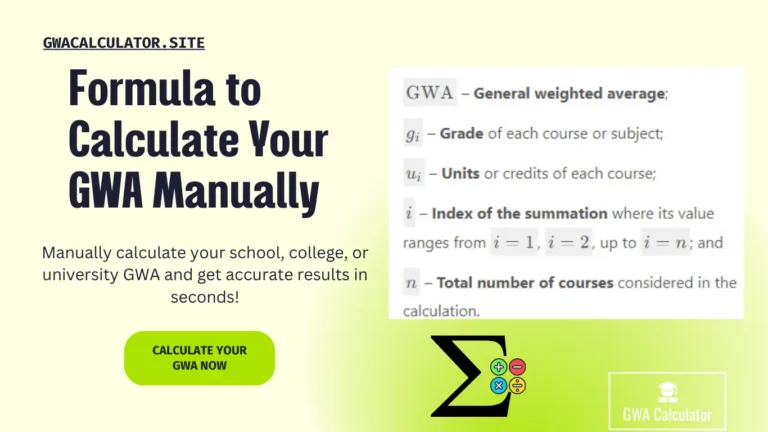College Grade Equivalent System in the Philippines: GPA and GWA Conversion
In the Philippines, students from high school to university are often concerned with one critical element of their academic life: grades. Grades are more than just a reflection of academic performance; they serve as benchmarks for students’ future opportunities, scholarships, and even career prospects. For many students and educators alike, understanding the college grade equivalent system is essential for navigating academic success.
This article dives deep into the college grade equivalent system in the Philippines, breaking down the various grading scales, how to interpret them, and how they compare to other educational systems. Whether you’re a student aiming to maintain a high GWA equivalent, a parent tracking your child’s performance, or an academic advisor helping students achieve their goals, this guide provides all the necessary insights.
What is the College Grade Equivalent System in the Philippines?
The college grade equivalent system in the Philippines varies slightly depending on the institution, but the general structure is based on a numeric grading scale. Universities and colleges use different grading systems to evaluate students’ performance, but they all focus on translating raw scores into grade point averages (GPA) or general weighted averages (GWA).
Here’s a typical college grade equivalent chart used by many universities in the Philippines:
| Numeric Grade | Percentage Equivalent | Remarks |
|---|---|---|
| 1.00 | 96-100 | Excellent |
| 1.25 | 93-95 | Very Good |
| 1.50 | 90-92 | Very Good |
| 1.75 | 87-89 | Good |
| 2.00 | 84-86 | Good |
| 2.25 | 81-83 | Satisfactory |
| 2.50 | 78-80 | Satisfactory |
| 2.75 | 75-77 | Fair |
| 3.00 | 70-74 | Passing |
| 5.00 | Below 70 | Failure |
This system uses a 1.00 to 5.00 scale, where 1.00 represents the highest possible grade and 5.00 represents failure. Grades between 1.00 and 3.00 are considered passing marks, while anything below 3.00 indicates academic difficulties or the need for improvement.
Grade Equivalent in College: How to Calculate Your GPA or GWA
To accurately interpret your grade equivalent in college, you need to understand how grades are computed. Most universities in the Philippines use the GWA (General Weighted Average) to evaluate a student’s overall academic performance.
Here’s a simple guide on how to calculate your GWA:
- Identify Your Grades and Credits: Gather all your grades for the semester or academic year. Each course typically has a certain number of credits or units that contribute to your GWA. The higher the unit count, the more weight that subject has on your overall average.
- Multiply Grades by Credits: For each subject, multiply the numeric grade by the number of units. For instance, if you scored a 2.00 in a 3-unit course, you would compute:2.00×3=6.002.00 \times 3 = 6.002.00×3=6.00
- Add Up All Weighted Grades: Sum the weighted grades (grade x unit) for all your subjects.
- Add Up All Units: Sum the total number of units for all the subjects you took.
- Divide the Total Weighted Grades by the Total Units: This will give you your GWA.GWA=Total Weighted GradesTotal Units\text{GWA} = \frac{\text{Total Weighted Grades}}{\text{Total Units}}GWA=Total UnitsTotal Weighted Grades
The Importance of Understanding Your GWA Equivalent
The GWA equivalent is crucial for students aiming for specific academic goals. Whether you’re vying for a spot on the Dean’s List, aiming for Latin Honors (such as Cum Laude, Magna Cum Laude, or Summa Cum Laude), or applying for scholarships, your GWA plays a significant role. Most universities in the Philippines set strict GWA requirements for these recognitions.
Here’s an example of how Latin Honors are awarded based on GWA equivalents in some Philippine universities:
- Cum Laude: GWA of 1.75 or higher
- Magna Cum Laude: GWA of 1.50 or higher
- Summa Cum Laude: GWA of 1.25 or higher
By understanding how your GWA equivalent stacks up, you can focus on improving your academic performance in areas where you need to raise your grade.
How the Philippine College Grading System Compares Globally
Many Filipino students or graduates who plan to study abroad or apply for international scholarships wonder how the Philippine grading system compares to global counterparts, particularly the GPA (Grade Point Average) system used in countries like the United States.
Here’s a comparison between the Philippine grading system and the US GPA system:
| Philippine Grade | US GPA Equivalent | Remarks |
|---|---|---|
| 1.00 | 4.00 | A |
| 1.25 | 3.75 | A- |
| 1.50 | 3.50 | B+ |
| 1.75 | 3.00 | B |
| 2.00 | 2.75 | B- |
| 2.25 | 2.50 | C+ |
| 2.50 | 2.25 | C |
| 2.75 | 2.00 | C- |
| 3.00 | 1.75 | D |
| 5.00 | 0.00 | F |
This comparison gives Filipino students a general idea of how their grades translate in an international context, which is especially useful for applications to foreign universities or when pursuing careers abroad.
What Factors Influence College Grades in the Philippines?
College grades in the Philippines are influenced by several factors, including:
- Examinations: Midterm and final exams often carry significant weight, sometimes accounting for as much as 40-50% of the final grade.
- Class Participation: Active participation in class discussions, group work, and presentations is encouraged and can contribute to the final grade.
- Projects and Assignments: Various projects, research papers, and assignments also play a crucial role, especially in courses that require practical application of theories.
- Quizzes and Recitations: Short quizzes and spontaneous recitations can also impact a student’s grade equivalent in college, especially in subjects that are theory-heavy.
- Attendance: Some professors in the Philippines also factor in attendance when calculating final grades.
The Impact of College Grade Equivalents on Career and Scholarships
The college grade equivalent system has far-reaching consequences for a student’s future. A high GWA can open doors to:
- Scholarship Opportunities: Both government and private scholarships often have minimum GWA requirements. Students who maintain a high academic standing are eligible for grants, financial aid, and scholarships, which can significantly ease the burden of tuition fees.
- Graduate School Admission: For those aiming to pursue master’s or doctoral programs, both locally and internationally, a high GWA is essential for admission.
- Employment: Some companies, particularly multinational corporations, place a strong emphasis on academic performance when recruiting fresh graduates. A high GWA may boost your chances of landing a prestigious job or internship.
Conclusion: Mastering the College Grade Equivalent System
Understanding the college grade equivalent system is crucial for students in the Philippines as they strive to achieve academic excellence and secure future opportunities. Whether you’re calculating your GWA equivalent for personal goals or applying for scholarships, being well-informed about how the grading system works can significantly impact your academic journey.
As you progress through your college education, stay mindful of how each assessment, project, and exam contributes to your overall GWA. Utilize online tools like GWA calculators and consult with your academic advisors to ensure that your grades align with your goals.







